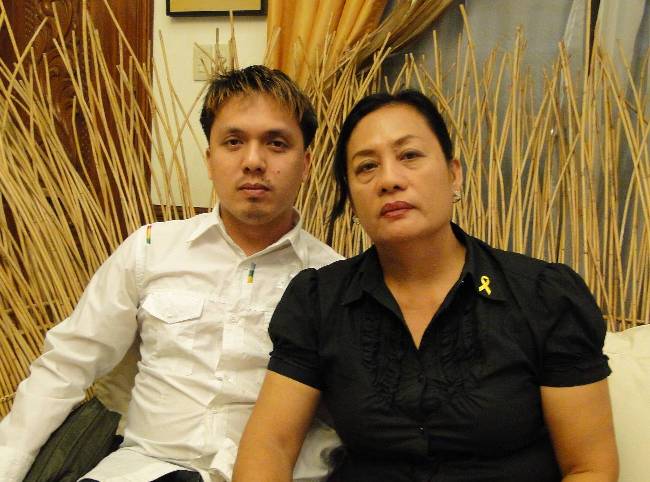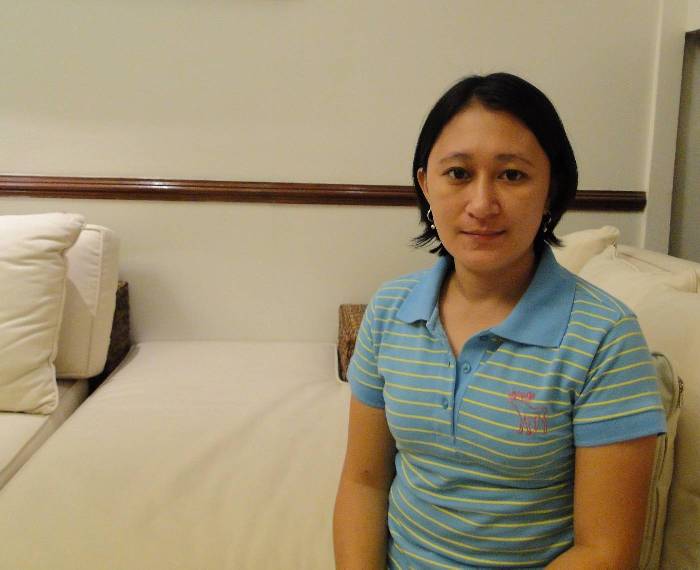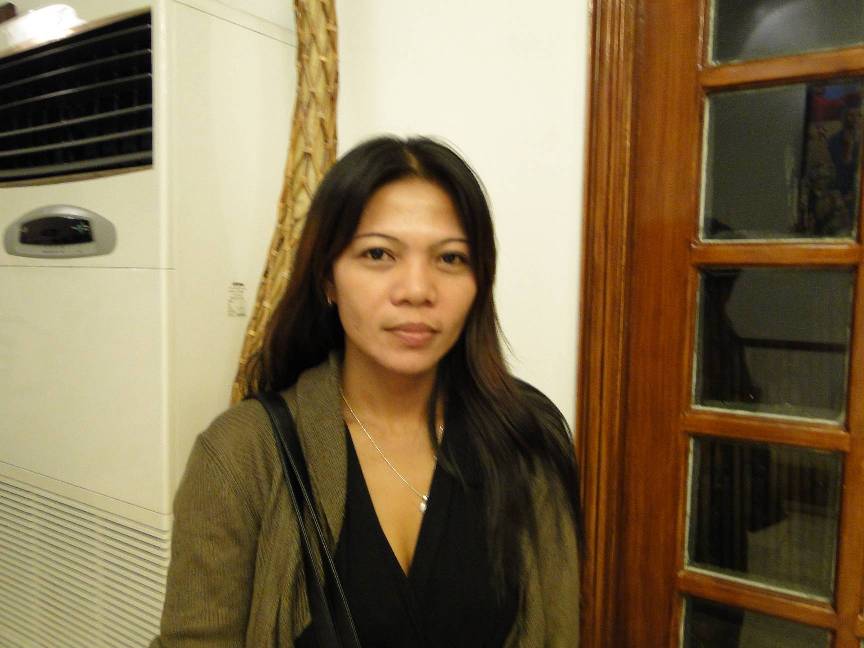By MYLAH REYES ROQUE

THEIR husbands were close friends but their wives did not know one another. The Ampatuan massacre changed that.
When they finally met, Myrna Reblando, Glenna Legarta and Mary Jean Merisco would refer to each other as 17, 20 and 19—the numbers assigned by the police to the bodies of their husbands found near each other at the scene of the crime. A fourth widow, Norma Parcon, said her husband’s body was among those buried and recovered by a backhoe.
None of the widows was allowed to walk up to the hill where 57 people, including 30 reporters and media workers were gunned down and mutilated on Nov. 23. It was only days later, after police pictures were leaked to the internet, that the women saw their husbands’ bodies.
Parcon did not see her husband in the photos but she would identify him later through copies of the raw police video reproduced by DVD traders. “Pag-angat ng backhoe, nalaglag yung green ID holder nya–alam ko siya yun (When the backhoe lifted a body, a green ID holder fell—and I knew it was him),” she said.
Myrna Reblando
In a live radio interview on the afternoon of Nov. 23, Myrna was told that her husband, Manila Bulletin reporter Alejandro “Bong” Reblado was dead. The Bombo Radyo interviewer told her that cadavers have been found and the police have arrived on the scene.
“Ano naman ang kuneksyon n’on (What’s the connection)?” Myrna remembers asking the interviewer who then told her that Bong’s face could no longer be identified but that there was no doubt he was among those killed. She refused to believe it.
Before the interview, Myrna was receiving calls that journalists who were covering the filing of the certificate of candidacy of Maguindanao Vice Mayor Datu Ismael “Toto” Mangudadatu had been held hostage. Bong had left for Buluan the night before despite her request for him not to do so. Receiving the news, she thought he was being held hostage for ransom by a renegade Muslim group. She started creating a mental inventory of possessions she could sell in order to raise the money and quickly secure his release.
Later, it crossed her mind that it could be an election-related confrontation between the Ampatuans and Mangudadatus but she felt confident that reporters like Bong would be spared from harm. Bong, 54, was a 20-year veteran of one of the top three national broadsheets, a stringer for international news organizations and quite well-known in the area.
More importantly, Myrna felt confident that her husband would not be harmed by an Ampatuan as she believed Bong enjoyed the confidence of the Ampatuan patriarch, Andal Sr. She remembers that on one occasion, Bong and one of their seven children even spent a night in one of the Ampatuan mansions during a long trip.
Myrna and her daughter kept calling Bong’s cell phone but he couldn’t be reached. Still, she said, “Hindi nawala ang pag-asa ko na buhay siya at nakatakas (I never gave up hope that he escaped and was still alive).”
She called up Bong’s sources in the military and police but no one answered. The following day, Myrna received confirmation, both from independent and official sources, that her husband was dead.
Bombo Radyo had her on one telephone line and Cotabato City Police Senior Supt. Willy Dangani on the other. She was describing what Bong was wearing: a polo shirt with colorful prints on a dark blue background, a brown belt with a silver buckle and denim tennis shoes. It was then that Dangani confirmed that Bong was among the dead, hogtied and still in the vehicle where he was apparently killed almost 24 hours earlier.
From their home in General Santos, Myrna traveled with her family for three hours to the crime site at Sitio Magating in Barangay Salman, Ampatuan, Maguindanao. Her son and a brother-in-law lifted Bong from the vehicle.
When she saw him, his face was unrecognizable but Myrna knew it was him. She was advised not to look “pero ayokong magsisi. Wala na ang utak, ang isang mata, ang kabila ng mukha, sabog ang ulo, wasak ang left arm (I did not want to regret anything. His brain was gone, so was one eye and one side of his face, his head had exploded, his left arm was crushed).”
Myrna thought the gunshots were limited to the head but there were several more in the body, legs and feet. She asked Dr. Raymond Cabling of the Scene of the Crime Operatives (SOCO) which was the fatal shot, and if Bong suffered. “Sa katawan daw dahil sabog ang lamang-loob. Nanginig ako (It was in the body because his innards had exploded. I felt a shiver).”
By this time, several agents of funeral parlors were already in the area offering their services to families of the victims. Myrna paid a P5,000 premium so that Bong’s body could be brought down from the site immediately.
The funeral parlors apparently wanted to save on transportation costs by collecting more bodies before making the trip to Koronadal City. His body was the first to be taken out of the site, even ahead of Genalyn Mangudadatu, wife of Toto Mangudadatu.
The day that Myrna recovered Bong’s body was their 25th wedding anniversary.
Noemi Parcon
Noemi Parcon’s husband, Pronterra Balita publisher Joel Parcon, 50, did not tell her that he was going to Buluan to cover a story. It was the norm in the Parcon household: Joel would disappear for days, returning home for a few days just to write and lay out the pages of the weekly publication which he would then take to General Santos City for printing. Married to Joel for 29 years, Noemi, 46, had long ago accepted that her husband kept odd hours.
At about 9 a.m. on Nov. 23, at about the time that the Mangudadatu convoy left Buluan for the Comelec office in Shariff Aguak, a neighbor who is also a policeman asked one of her children if Joel had joined the Ampatuan coverage. There was no doubt in Noemi’s mind that he was there.
“Walang lakad ang mga Mangudadatu na hindi siya kasama (He would always be where the Mangudadatus went),” she said. That her policeman-neighbor had asked about Joel’s whereabouts long before news of the killing broke out would reinforce reports later that many people have already heard of the Ampatuans’ plan to prevent the Mangudadatus from reaching the Comelec office.
At 9:30 a.m., which was about the time that the Mangudadatu convoy was stopped in Ampatuan town, Noemi’s daughter Hazel Rosette dialed her father’s cell phone. Joel did not answer but he accepted the call, allowing her to hear a commotion of sorts as well as several voices. She could hear the sounds until she ran out of cell phone load. She reloaded her phone but when she called him up again, the phone just kept ringing.
Even when rumors of the hostage-taking had reached them, Noemi was unperturbed. Like the other widows, she was certain that media workers like Joel were not going to be hurt.
Her daughter kept dialing the cell phone and at 1:30 a.m. someone did answer the call. The person spoke in Tagalog but she was so surprised that she chose to end the call. By this time, Noemi remembered hearing radio reports emphatically declaring, “’Yung kasama sa convoy, 100 percent walang buhay (100 percent of those who were in the convoy are dead).”
This report, however, would be denied later as Mangudadatu supporter Sandamen Rajah Ali and two others who were at the tail end of the convoy would testify that they were able to drive away when they heard gunshots.
A confirmation that Joel was dead came soon. At 9:30 p.m. of the same day, someone finally answered the cell phone of her husband and whispered in reply to her query, “Patay na, patay na (He’s dead, he’s dead).” To date, she does not know the identity of the person who answered; nor has she recovered Joel’s cell phone.
The following day, Noemi was among the other widows who tried but were not allowed to go up to the mass graves. She had wanted to retrieve Joel’s body on that same day but at 4:30 p.m., one of her husband’s co-workers in media advised her to go home because it was getting dark and despite the presence of the military, it was not safe.
In Koronadal City that night, Noemi remembers going from one funeral parlor to another and failing to locate the body. She had gone to Southern Funeral Homes, Allen Memorial Homes and Zubiri Funeral Homes. One of her children, however, kept insisting that she had a hunch that her father was at Southern.
Back at the funeral parlor, Noemi asked one of the workers to wash a body covered in dirt, which they had previously overlooked. At 2 a.m. on Nov. 25, Noemi finally found Joel. She recognized him not through his face but through the clothes he wore.
“Suot n’ya ’yung polo shirt na gift ko, naka-jacket. Wala nang bibig dahil doon lumabas ang bala, luwa ang kaliwang mata, wala na ang buhok (He was wearing the polo shirt that was my gift to him, he wore a jacket. His mouth was gone because that was where the bullet had exited, his left eye was popping out, his hair was gone),” she says.
Her daughter Apple Joy refused to look at Joel’s remains but would see these days later anyway in a copy of the police video sold by DVD peddlers. They would see Joel’s body being recovered by a backhoe.
Today, Noemi says, “Parang walang nagbago, sanay na ako na lagi siyang wala (Nothing much has changed, I am used to his absence).”
For the past 25 years, Noemi feels that basically she raised her three children singlehandedly and sent them to college. Married at 17, she struggled to finish college while pregnant, becoming a teacher at Notre Dame of Marbel University and later at the Koronadal National Comprehensive High School.
Today, she augments her income by offering tutorial services after school hours. She would hop on her motorcycle and, at one time, tutored as many as seven children one after the other. She admits she would sometimes earn more from the tutorials than from her regular teaching job.
Like two other widows, she has long ago accepted that a journalist’s wife needs to have a constant source of income. Joel left a steady job as a government worker to become a journalist, a job which Noemi knew made him happier.
She also knew he had a relationship with other women and was unsurprised when, during Joel’s wake, one of the three women that she knew about, asked for her permission to visit. She granted the request and, at her own children’s prodding, even gave the woman some money on account of the baby she had brought with her.
Despite being used to her husband’s absence even when he was still alive, Noemi feels the pangs of missing him. This, she says, does not diminish her intent to find justice.
Mary Jean and Glenna

Mary Jean Merisco and Glenna Legarta knew their husbands were best buddies–apparently, up to the end. Rey Merisco, 34, of Periodico Ini and Bienvenido “Jun” Legarte, 36, of Pronterra Balita, were found beside each other, sprawled on the ground beside a vehicle. They were among the 22 bodies that the fleeing killers failed to bury. SOCO numbered their bodies as 19 and 20.
“Alam mo na ba (Have you heard about it)?”
It was Glenna, 36, who called up Mary Jean on Nov. 23 regarding the reported abduction of about 40 media members. At 9:32 a.m., Glenna dialed Jun’s cell phone. It rang and then abruptly she heard the message that it was out of coverage. She kept calling but could not reach him.
Between 4 and 5 p.m. of the same day, she heard from the radio the names of those who were confirmed dead. To this date, she recites the order in which the names were read: Jun was the fifth. She did not doubt the veracity of the report and remembers being hysterical immediately after hearing his name.
Rey and Jun’s bodies were among the 46 bodies brought down from the crime scene on Nov. 24, a day after the killing. Glenna regrets not going to the hills of Barangay Salman where the killings occurred. She saw Jun’s body at the funeral parlor and her last image of him was of someone she did not know.
“Bloated na, grabe ang laki, hindi ko na makilala (His body was bloated and was so large that I could not recognize him,” she says.
 It was the face that Glenna remembers vividly because it bore torture marks. “He was in the red T-shirt that I bought for him, blue pants, brown leather shoes,” she says. The shots fired at Jun were so powerful that his left arm was severed from his shoulder and the left side of his pelvis bore a huge, gaping hole. Glenna spared her three children (11, 8 and 5 years old) from the sight of their murdered father.
It was the face that Glenna remembers vividly because it bore torture marks. “He was in the red T-shirt that I bought for him, blue pants, brown leather shoes,” she says. The shots fired at Jun were so powerful that his left arm was severed from his shoulder and the left side of his pelvis bore a huge, gaping hole. Glenna spared her three children (11, 8 and 5 years old) from the sight of their murdered father.
While others could describe their husband’s bodies in detail after the killings, Mary Jean, 31, often keeps quiet. Among the first set of pictures that spread in the internet was that of Rey, clad in a dark shirt, gray pants and brown shoes. His body was lying on its right side, the lower left portion of the back of his head bearing a huge hole. The left pocket of his pants was turned inside out, the belt hanging open.
Jun had worked for various Koronadal-based publications in the past 11 years and was at one time the publisher of Rapido News. In fact, Glenna thought Jun was going to Buluan to help distribute copies of Rapido instead of going to a political coverage.
The day before the killings, Glenna had sent a text message to her husband, asking him to consider changing jobs as this one kept him out late at night and exposed him to danger. Jun replied by text, “Oo, ma, pagkatapos nito (Yes, ma, after this).”
Rey had been a journalist for the past three years. An accountant, he left the job he has held for nine years as a pawnshop manager to become a reporter for the weekly Peyodiko Ini which is published in a combination of Hiligaynon, English and Filipino.
Mary Jean admits that even as she supplements Jun’s income as a pre-school clerk, they barely made enough to provide for their eight-year-old daughter. But Rey was chasing a life-long dream that began when he was a high school campus journalist: he wanted to be a publisher.
He was able to achieve that with Tingog Mindanaw, a four-page weekly. The publication was going on its second issue which Rey intended to distribute upon returning from covering Mangudadatu’s filing of his certificate of candidacy for mayor. Now, copies of that issue remain stacked at their home.
(Mylah Reyes Roque is a freelance journalist and the wife of Harry Roque, counsel for families of the victims of the Ampatuan massacre.)